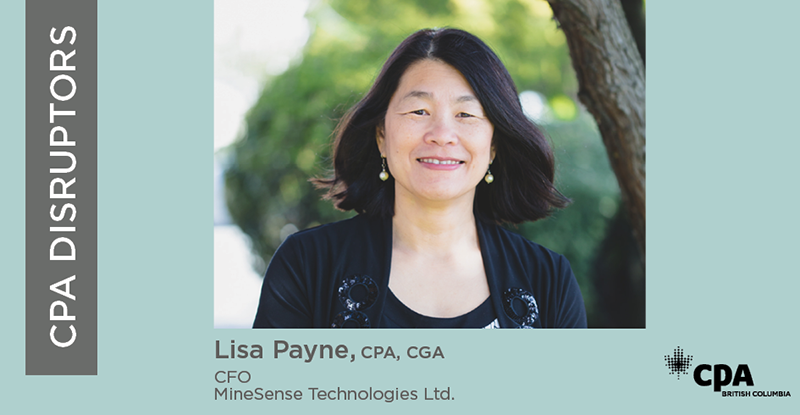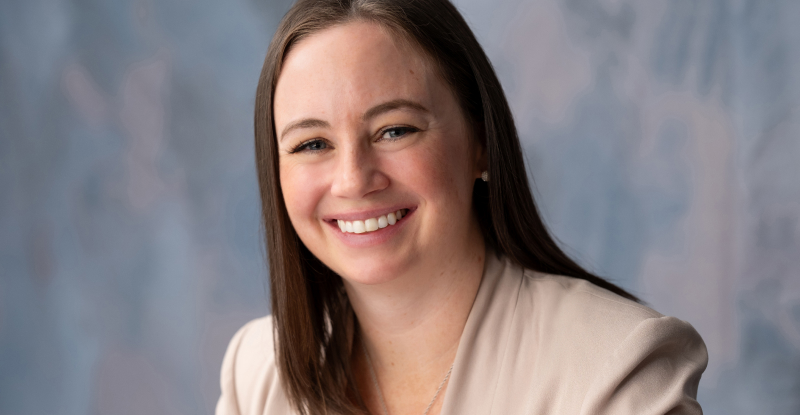
Disruptor company: MineSense Technologies Ltd.
CFO: Lisa Payne, CPA, CGA
Company headquarters: Vancouver, BC
Key technologies: Edge computing, data analytics, proprietary algorithms, IoT
Disrupting: Mining industry, mining technology
Until very recently the process of metal mining was characterized by a lack of visibility. Only after the lengthy, costly, and resource-intensive process of extracting material from the earth and sending it for processing and refining, would the true value of the material be confirmed. However, MineSense™ has eliminated this lack of visibility, and disrupting the mining industry in the process.
“Our company develops smart technologies for the mining industry – specifically metallic mines – that enable the mine operator to ‘see’ the quality of the ore with every shovelful of rock as it being extracted from the mine site,” says Lisa Payne, CPA, CGA, and CFO of the mining technology company MineSense.

MineSense has developed smart sensors that use data analytics to more effectively sort ore from waste during the mining process. The sensors can be installed in the buckets of mobile mining equipment including frontend loaders and excavators, as well as on conveyor belts. Photo credit: Wink Photography
The company has developed sensors that can be installed onto the buckets, or shovels, of mobile mining equipment such as excavators, and these sensors use data analytics to inform the mine operator of the ore concentration as material is dug out of the earth. Essentially, the technology allows mining companies to see the value of material as it is being mined, bucket by bucket.
“Our technology enables the mine operator to make real-time decisions early in the mining process to route ore to the mill for valuable mineral extraction or to the waste pile. The earlier a mine operator can make decisions, the greater the impact and value to the mine, since all downstream processes such as processing, refining, and sales can benefit,” Lisa elaborates. The company has also developed similar sensors that can be installed in conveyor belts in mining operations.

Buckets containing iron ore samples, which will be analyzed and scanned using a lab-scale version of MineSense’s BeltSense and ShovelSense systems. Photo credit: Wink Photography
Forward-thinking leadership drives innovation
With 25-plus years of leadership experience at organizations such as the BC Innovation Council and as a mentor to a number of BC start-ups, Lisa is no stranger to working with innovation-focused businesses and advancing new concepts. Along the way, she has been recognized by BC Business as one of the province’s most influential women in the STEM fields, and as one of the top 10 women in technology by Business in Vancouver. “It’s easier to look forward to each day and far more rewarding when you put yourself in a position to make a difference,” she says. “Tech companies depend on innovation to facilitate high-paced growth. Nothing is stagnant and innovation helps us adapt to changes.”

MineSense CFO Lisa Payne, CPA, CGA, and team members at the company’s headquarters in Vancouver, BC. MineSense also has offices and field personnel in South America, Australia, and Africa. Photo credit: Wink Photography
Addressing the mining industry’s biggest challenges
In a global market characterized by volatile change, many mines are turning to new technologies to stay competitive. “Global challenges facing the mining industry include depletion of high-quality metal resources and increasing political and environmental barriers restricting the development of new mines,” says Lisa.
MineSense’s technology enables mines to address current industry challenges and stay competitive. “Using predictive analytics on raw data collected by our sensors, in combination with other data compiled from materials surrounding the substance being mined, our algorithms detect patterns and generate unique insights that were never attainable before,” she says. “This technology has a transformative impact on the mine’s bottom line by increasing its revenue and decreasing its costs per unit of metal recovered.”

MineSense’s first version of the BeltSense machine, which scans and analyzes mined material. MineSense technology provides a hardware and software system, enabled by proprietary algorithms, that measures and reports ore grade and ore characteristics. Photo credit: Wink Photography
Focus on sustainability: Disruption through cleantech
MineSense is also disrupting the mining industry through its ability to reduce environmental impacts traditionally associated with mining and to extend mine life.
Lisa explains, “Traditionally, mines determined what rock to send to the mill for extraction and what rock to send to the waste pile by taking samples at varying intervals to develop block models. The models are used to create a mine map that identifies ore and waste. Using the assumption that ore in rock is homogeneous, they follow this map and send a given block to the mill or waste pile accordingly. In error, a substantial amount of higher concentration ore is sent to the waste pile.”
Similarly, waste is inadvertently processed at the mill. “Imagine the amount of energy and water consumed unnecessarily to process this waste,” she notes. “For example, up to 60% of a mine’s energy budget goes towards crushing and grinding rock, which may have no value.”
“Because our technologies allow companies to more accurately sort ore from waste, they decrease environmental impacts through reduced greenhouse gas emissions, water and energy consumption per unit of metal recovered, and enable mines to optimise the use of resources. According to one study, ore sorting can reduce water consumption by up to 18%.”

MineSense’s technology works by collecting data from multiple
sensors during the ore digging process and applying algorithms to
determining ore characteristics. “Sensor data is collected on a
bucket by bucket level. This provides immediate information to
operations at the front end of the mining process allowing better
decisions for downstream processes,” says Lisa. Photo credit:
Wink PhotographyBuilding on success to enter new markets
MineSense has seen its technology adopted in BC, including at Canada’s largest open pit copper mine, Teck’s Highland Valley Copper operation in Logan Lake, which reported a net measurable increase in the amount of ore it extracted after adopting MineSense’s technology.
MineSense has since pursued new opportunities in BC and beyond. After achieving success with copper mines in North America, the company is expanding to markets in South America, Africa, and Australia. It is also working to capture and interpret new types of data. “We are expanding our capabilities to other base metals. For example, our technology is now being used to flag materials containing elevated concentrations of harmful elements such as arsenic,” Lisa says. “We are also developing methods to predict non-metal material characteristics, such as ore hardness, that directly impact safety, processing costs, and efficiency.”
Strategies for scaling up in the tech industry
Amidst this growth Lisa has addressed the company’s financing needs, including those it faced as a start-up and pre-commercial company. “We found investors whose investment strategies are aligned with each stage of our growth,” she says. “And to complement equity capital, we’ve leveraged non-dilutive capital so we can reduce risk and optimize value for our shareholders.”
“SR&ED and government supported programs invest in companies like ours, and help to reduce financial risk when developing new technology by funding research, development, and customer field trials. For example, the National Research Council of Canada Industrial Research Assistance Program (NRC-IRAP) is supporting our research and development projects. And Sustainable Development Technology Canada (SDTC) and the Government of BC’s Innovative Clean Energy Fund (ICE) support customer field trials for commercialization.”
As a team leader, Lisa says, “My tendency is to lead through mentorship, not through micromanagement. I hire capable people and trust them to do their jobs well.” Photo credit: Wink Photography
Commenting on the strategies she uses to address growth as MineSense has scaled up, Lisa says, “It’s a good idea to hire better talent than you think you need – it is easier to scale up with experienced people. At the same time, we are constantly aware that our resources – money, time, and people – are limited and must be used wisely.” She adds, “For tech companies, Verne Harnish’s strategic planning tools are excellent.”
In closing, Lisa emphasizes that her work with MineSense is about much more than finance. “I really enjoy people and business development,” she says. “As CFO, I am continually promoting the company to investors, funders, employees, and other potential stakeholders. As a member of the tech industry, building high growth companies takes a lot of energy, drive, and commitment.”
"As a CPA, I have had a very exciting and unconventional career and it has allowed me to work in a diversity of industries."
Related articles
- Construction industry disruptor builds housing solutions
- Beyond the numbers: What today’s CPAs actually do
- A CPA designation was key to Matthew Anderson launching A&K Robotics
Leah Giesbrecht is a communications coordinator with the Chartered Professional Accountants of British Columbia.



